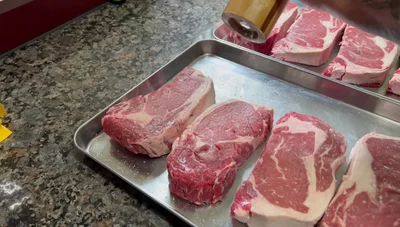The ribeye steak: a culinary masterpiece known for its rich marbling and intense flavor. Achieving the perfect sear and internal temperature, however, can be a challenge, often resulting in either a charred exterior and raw interior, or a dry, overcooked disappointment. But what if there was a foolproof method, a technique that guaranteed juicy, tender perfection every single time? There is! This article explores the wonders of reverse searing ribeye steaks – a technique that prioritizes even cooking before achieving that coveted, flavorful crust.
Forget the guesswork and the anxieties of overcooking; reverse searing offers unparalleled control and consistency. This method involves gently cooking the steak to its desired internal temperature in the oven before achieving a satisfyingly crisp sear in a screaming hot pan. Ready to transform your steak game and enjoy restaurant-quality ribeyes at home? Let's dive into the step-by-step process to perfectly cooked ribeye steaks every single time.
Preparation and Safety Guidelines
- Gas Grill
- Sheet Pan
- Meat Thermometer
- Avocado Oil
- Barbecue Seasoning
- Sea Salt
- Use a food thermometer to ensure the steak reaches a safe internal temperature of at least 145°F (63°C) for medium-rare, or higher for your desired doneness. Don't rely on visual cues alone.
- Always allow the steak to rest for at least 5-10 minutes after cooking. This allows the juices to redistribute, resulting in a more tender and flavorful steak.
- Handle raw meat carefully. Wash your hands, cutting board, and utensils thoroughly before and after handling the steak to prevent cross-contamination.
Step-by-Step Instructions
Preparation
- Dry brine steaks with sea salt and refrigerate for a few hours (or overnight if possible).
- Spray steaks with avocado oil and apply a beef rub.


Preparation Initial Cook (Indirect Heat)
- Preheat gas grill to medium-low heat (using about 3 burners, leaving the others off for indirect heat).
- Place steaks on the cooler side of the grill (indirect heat) to cook slowly and evenly, aiming for an internal temperature of 120-125°F (49-52°C).
- Monitor the internal temperature using a meat thermometer. Flip steaks once they reach approximately 80-90°F (27-32°C).
- Continue cooking on indirect heat until the steaks reach 115-120°F (46-49°C).



Initial Cook (Indirect Heat) Sear (Direct High Heat)
- Increase grill heat to high. Sear steaks for approximately one minute per side, rotating 90 degrees halfway through to create nice grill marks.

Sear (Direct High Heat) Rest and Serve
- Remove steaks from grill and let them rest for at least 10-15 minutes before slicing and serving.

Rest and Serve
Read more: Fire Honey Glazed Shrimp Recipe
Tips
- Dry brining helps to season the meat and draw out moisture, resulting in a more flavorful and tender steak.
- Using a meat thermometer ensures that the steaks are cooked to the desired level of doneness.
- Allowing the steaks to rest is crucial for retaining juices and achieving optimal tenderness.







